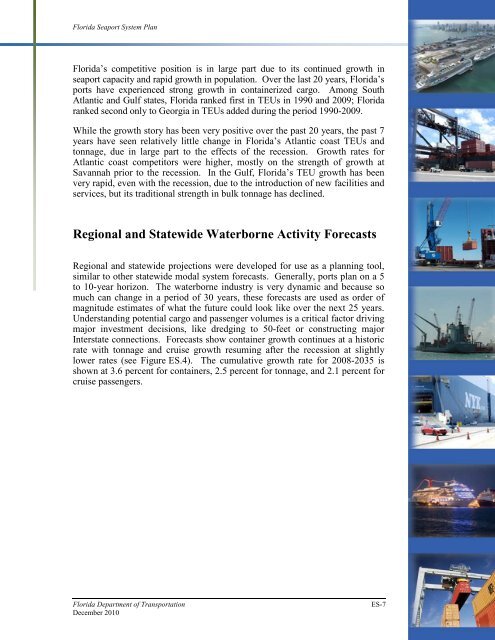Florida Seaport System Plan - SeaCIP
Florida Seaport System Plan - SeaCIP
Florida Seaport System Plan - SeaCIP
Create successful ePaper yourself
Turn your PDF publications into a flip-book with our unique Google optimized e-Paper software.
<strong>Florida</strong> <strong>Seaport</strong> <strong>System</strong> <strong>Plan</strong><br />
<strong>Florida</strong>’s competitive position is in large part due to its continued growth in<br />
seaport capacity and rapid growth in population. Over the last 20 years, <strong>Florida</strong>’s<br />
ports have experienced strong growth in containerized cargo. Among South<br />
Atlantic and Gulf states, <strong>Florida</strong> ranked first in TEUs in 1990 and 2009; <strong>Florida</strong><br />
ranked second only to Georgia in TEUs added during the period 1990-2009.<br />
While the growth story has been very positive over the past 20 years, the past 7<br />
years have seen relatively little change in <strong>Florida</strong>’s Atlantic coast TEUs and<br />
tonnage, due in large part to the effects of the recession. Growth rates for<br />
Atlantic coast competitors were higher, mostly on the strength of growth at<br />
Savannah prior to the recession. In the Gulf, <strong>Florida</strong>’s TEU growth has been<br />
very rapid, even with the recession, due to the introduction of new facilities and<br />
services, but its traditional strength in bulk tonnage has declined.<br />
Regional and Statewide Waterborne Activity Forecasts<br />
Regional and statewide projections were developed for use as a planning tool,<br />
similar to other statewide modal system forecasts. Generally, ports plan on a 5<br />
to 10-year horizon. The waterborne industry is very dynamic and because so<br />
much can change in a period of 30 years, these forecasts are used as order of<br />
magnitude estimates of what the future could look like over the next 25 years.<br />
Understanding potential cargo and passenger volumes is a critical factor driving<br />
major investment decisions, like dredging to 50-feet or constructing major<br />
Interstate connections. Forecasts show container growth continues at a historic<br />
rate with tonnage and cruise growth resuming after the recession at slightly<br />
lower rates (see Figure ES.4). The cumulative growth rate for 2008-2035 is<br />
shown at 3.6 percent for containers, 2.5 percent for tonnage, and 2.1 percent for<br />
cruise passengers.<br />
<strong>Florida</strong> Department of Transportation<br />
December 2010<br />
ES-7
















